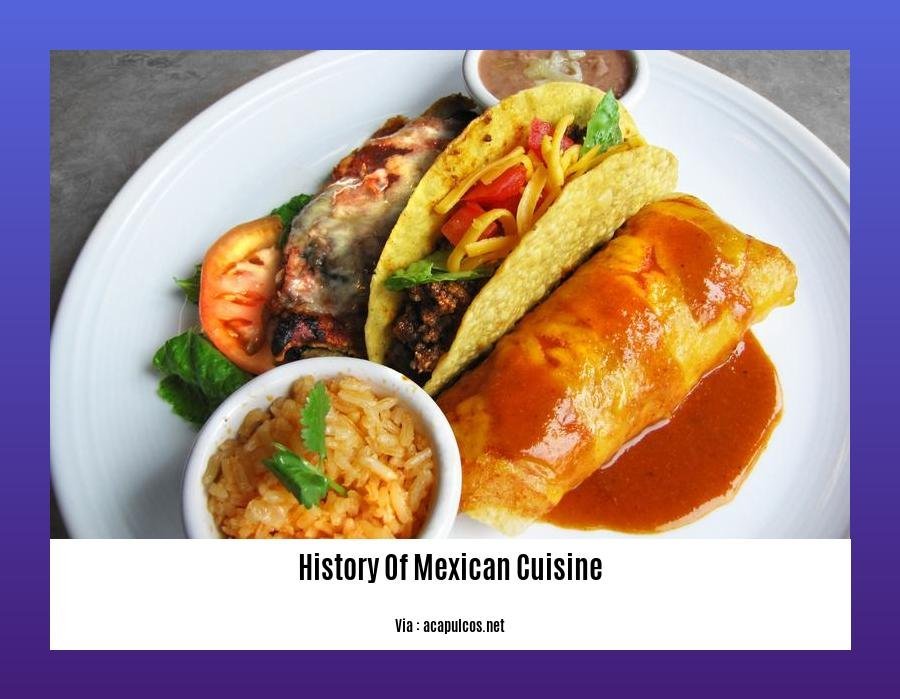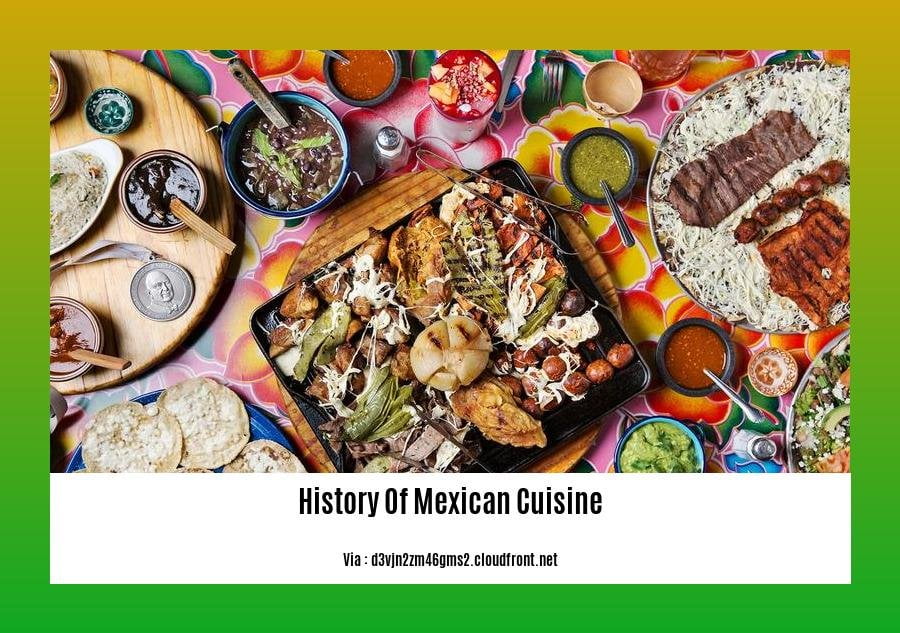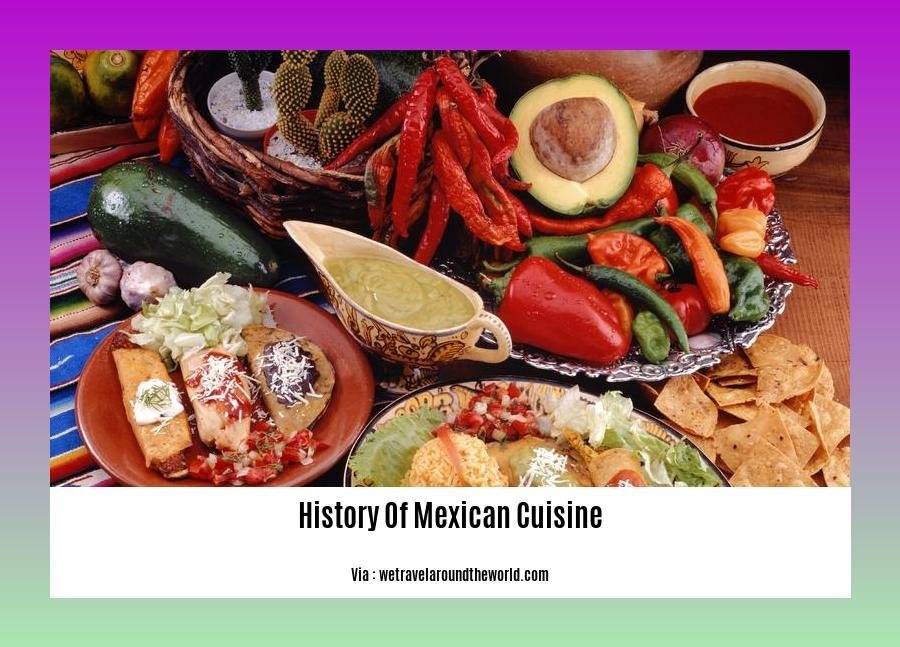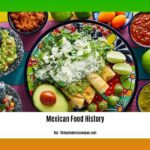Embark on a tantalizing culinary adventure as we delve into the captivating history of Mexican cuisine in our article, “Unveiling the History of Mexican Cuisine: A Culinary Journey Through Centuries”. Rooted in ancient civilizations and enriched by Spanish, French, and indigenous influences, Mexican gastronomy is a vibrant tapestry of flavors, colors, and traditions. Prepare your taste buds for an exploration of the evolution of Mexican dishes, from their humble origins to their current status as culinary masterpieces.
Key Takeaways:
-
Mexican cuisine is rooted in ancient Mesoamerican cuisine and has evolved over centuries.
-
Indigenous ingredients, combined with those brought by Spanish conquistadors, form the foundation of Mexican dishes.
-
Early agricultural communities, like the Olmec and Maya, developed nixtamalization, domesticated maize, and established foodways.
-
Mesoamerican groups, such as the Teotihuacanos, Toltec, Huastec, Zapotec, Mixtec, Otomi, Purépecha, Totonac, Mazatec, Mazahua, and Nahua, contributed their unique cooking methods.
-
With the rise of the Mexica Empire, culinary traditions merged, leading to the development of Aztec cuisine.
-
Mexican cuisine’s staple ingredients include corn, turkey, beans, squash, amaranth, chia, avocados, tomatoes, tomatillos, cacao, vanilla, agave, spirulina, sweet potato, cactus, and chili peppers.
History of Mexican Cuisine


Mexican cuisine is a symphony of flavors, colors, and aromas that has captivated the world. Its roots can be traced back to the ancient civilizations of Mesoamerica, where maize, beans, and squash formed the foundation of their diet. Spanish conquistadors arrived in the 16th century, bringing with them new ingredients such as wheat, rice, and livestock, which further enriched the culinary landscape.
Culinary Masterpieces of Ancient Civilizations
- The earliest agricultural communities, such as the Olmec and Maya, domesticated maize, discovered the process of nixtamalization, and laid the groundwork for Mexican cuisine.
- Over time, other groups in Mesoamerica, including the Teotihuacanos, Toltec, Huastec, Zapotec, Mixtec, Otomi, Purépecha, Totonac, Mazatec, Mazahua, and Nahua, contributed their unique cooking methods and ingredients, forming a rich tapestry of culinary traditions.
- When the Mexica Empire rose to power, these culinary influences converged, giving birth to Aztec cuisine, which marked a milestone in Mexican culinary history. Staples of Aztec cuisine included maize, turkey, beans, squash, amaranth, chia, avocados, tomatoes, tomatillos, cacao, vanilla, agave, spirulina, sweet potato, cactus, and chili peppers.
The Fusion of Cultures
- The arrival of the Spanish in the 16th century marked a transformative period in Mexican cuisine. New ingredients, such as wheat, rice, pork, and beef, were introduced, creating a culinary fusion that continues to define Mexican gastronomy.
- Spanish culinary techniques, such as frying, sautéing, and stewing, were incorporated into traditional Mexican cooking methods, resulting in a harmonious blend of flavors and textures.
- Over time, regional variations emerged, reflecting the diverse geography and cultures of Mexico. The northern states, influenced by their proximity to the United States, developed a cuisine characterized by grilled meats and Tex-Mex dishes.
- In the central region, a blend of indigenous and Spanish influences resulted in dishes such as mole poblano and enchiladas.
- The southern states, with their tropical climate, showcased a cuisine rich in seafood, tropical fruits, and spicy sauces.
A Culinary Legacy That Endures
- Mexican cuisine is more than just a collection of dishes; it is a cultural heritage that has been passed down through generations.
- It is a testament to the resilience of the Mexican people and their ability to adapt and innovate while staying true to their culinary roots.
- Today, Mexican cuisine is celebrated around the world, and Mexican restaurants can be found in every corner of the globe.
- It is a cuisine that continues to evolve, incorporating new ingredients and influences while remaining rooted in its rich history and traditions.
Just like a symphony, Mexican cuisine is a harmonious blend of flavors, textures, and colors. It is a cuisine that has stood the test of time, adapting and evolving while remaining true to its roots. It is a cuisine that is celebrated around the world, a testament to the enduring legacy of Mexican culture.
For an appetizing history of Mexican cuisine, look at the evolution of Mexican dishes here! Alternatively, explore the chronicle of Mexican food here for a delectable journey into its past.
History of Mexican Food Culture
Mexican cuisine, renowned for its unique blend of flavors, is a testament to the rich cultural heritage of Mexico. Let’s embark on a culinary journey through time to unravel the captivating history that shaped this vibrant cuisine.
Uncovering the Roots: Ancient Civilizations and Influences
Culinary Roots: The history of Mexican cuisine can be traced back to the ancient civilizations of the Mayans, Aztecs, and other Mesoamerican groups. These civilizations had distinct foodways, utilizing locally available ingredients and developing staple dishes that would later become integral to Mexican cuisine.
– The Mayans: They relied on hunting and gathering for sustenance, with tortillas, corn, beans, and squash forming the foundation of their diet.
– The Aztecs: The Aztecs introduced tomatoes, chili peppers, and chocolate to the culinary landscape, bringing a new level of flavor and diversity to the region’s cuisine.
– Spanish Influences: With the arrival of Spanish conquistadors in the 16th century, Mexican cuisine underwent a significant transformation. European ingredients, such as wheat, dairy, and pork, were integrated into traditional dishes, creating a fusion that would shape the future of Mexican gastronomy.
The Evolution of Modern Mexican Cuisine: A Tapestry of Flavors
Through centuries of culinary evolution, modern Mexican cuisine has emerged as a vibrant tapestry of flavors, techniques, and traditions.
– Regional Variations: Mexico’s diverse geography has resulted in regional variations in cuisine, reflecting the unique cultural and environmental influences of each region.
– The Rise of Street Food: Street food plays a crucial role in Mexican culture, with vendors offering a variety of flavorful dishes, from tacos and tortas to tamales and elotes.
– International Recognition: In recent years, Mexican cuisine has gained international acclaim, with chefs around the world incorporating Mexican ingredients and flavors into their creations.
Preserving the Culinary Legacy: Traditions and Festivals
The rich history of Mexican food culture is celebrated through various traditions and festivals.
– Dia de los Muertos: The Day of the Dead is a significant festival in Mexico, where families honor their deceased loved ones with elaborate altars and traditional dishes, such as pan de muerto and mole.
– Fiestas Patrias: Mexican Independence Day is a time for celebration, with street parties, traditional dances, and food stalls offering a wide array of Mexican delicacies.
Key Takeaways:
- The history of Mexican food culture is a blend of ancient Mesoamerican traditions and European influences, creating a diverse and flavorful cuisine.
- This history of Mexican food culture includes dishes that originated with the Maya, Aztec, and Spanish cultures, such as tortillas, corn, beans, tomatoes, chili peppers, and chocolate.
- The history of Mexican food culture continued to be shaped by the arrival of Spanish colonizers, who brought their own ingredients and cooking techniques to Mexico leading to the integration of European and indigenous foods in Mexican cuisine.
- Modern Mexican cuisine is a diverse and regional affair, with regional versions influenced by indigenous and European ingredients, as well as unique preparation techniques.
- Street food plays a vital role in Mexican culture, with many regional specialties originating from the streets of Mexico’s cities.
References:
- Traditional Mexican Food
- History of Mexico’s Cuisine
FAQ
Q1: What is the origin of Mexican cuisine?
A1: Mexican cuisine has its roots in Mesoamerican cuisine, with influences from Spanish, French, and indigenous cultures.
Q2: What were some of the earliest agricultural communities that contributed to Mexican cuisine?
A2: Early agricultural communities such as the Olmec, Maya, Teotihuacanos, Toltec, Huastec, Zapotec, Mixtec, Otomi, Purépecha, Totonac, Mazatec, Mazahua, and Nahua all contributed to the development of Mexican cuisine.
Q3: What were some of the key ingredients brought by the Spanish conquistadors that influenced Mexican cuisine?
A3: The Spanish introduced European ingredients such as wheat, cheese, and pork, which became integral to Mexican cuisine.
Q4: What is the significance of maize, turkey, beans, squash, and chili peppers in Mexican cuisine?
A4: These ingredients are considered food staples in Mexican cuisine, with maize being the foundation of many dishes, turkey being a traditional protein source, beans and squash providing nutritional value, and chili peppers adding a distinctive flavor profile.
Q5: How did the Mexica Empire influence Mexican cuisine?
A5: With the rise of the Mexica Empire, culinary traditions from various Mesoamerican groups were infused, leading to the development of Aztec cuisine, which laid the foundation for modern Mexican cuisine.
- Unveiling the Enigma: Mansoureh Khojasteh Bagherzadeh’s Public Appearances & Private Life in Iran - July 18, 2025
- Unveiling the Mystery: Mansoureh Khojasteh Bagherzadeh’s Husband: A Rare Glimpse into a Private Life - July 18, 2025
- Unveiling Masoud Khamenei’s Mother: Power, Influence, and Iran’s Future - July 18, 2025
















